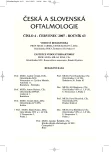Analysis of Movement Disorders Surgeries at the Department of Ophthalmology, the FNKV Hospital, Prague, Czech Republic, during the Ten-Years Period
Desetiletý rozbor operací poruch motility na Oční klinice FNKV v Praze
Autoři analyzovali 1644 operací strabismu a ptózy v průběhu desetiletého období roku 1997 až 2006 na Oční klinice FN Královské Vinohrady v Praze. Operace rozdělili do tří věkových skupin pacientů: 531 operací bylo u pacientů do 6 let a 508 operačních výkonů bylo u dětí a mladistvých od 7 do 18 let, dále studie zahrnovala 605 operačních postupů u dospělých starších 19 let. Operaci strabismu tvořilo 1401 samostatných či rozfázovaných operačních postupů a korekce ptózy byla provedena u 243 nemocných. Nejčastějším chirurgickým výkonem u strabismu byly oslabující či posilující operační techniky na horizontálních svalech v 65 %. U oslabujících technik autoři jednoznačně preferovali dózovatelnou parciální myotomii podle Gonina-Hollwicha, která tvořila 51 % operací na horizontálních svalech. Význam této operace podtrhovaly velice příznivé výsledky u operací kongenitální esotropie, Duanova syndromu I. a excesu divergence. Tato operační technika byla zařazena jako oslabující výkon v rámci Kestenbaumova postupu při řešení tortikolis pro horizontální nystagmus. Samostatný operační výkon na šikmých a vertikálních svalech byl proveden v 16 %, kdy nejčastějším operačním postupem byl retropozice dolního šikmého svalu podle Parkse a na druhém místě jeho parciální myotomie elektrokauterem podle Romera-Martineze. Oslabující operace byly použity společně na horizontálních a šikmých svalech v 10 %. Rozličné operační techniky včetně transpozičních byly indikovány při parézách zevních očních svalů a tortikolis. Představovaly celkově 12 % ze všech operačních výkonů pro strabismus. Nejčastější operací ptózy u dětí a mladistvých představoval frontotarzální závěs podle Foxe (51 %) a u dospělých to byla tarzoresekce horního víčka podle Fasanelly (74 %).
Klíčová slova:
operace strabismu, operace ptózy, parciální myotomie podle Gonina- Hollwicha
Authors:
J. Krásný; R. Brunnerová; J. Syslová; J. Ciprychová *; Čeledová
Authors‘ workplace:
Ortoptistky pracující v průběhu desetiletého období
na Oční klinice FNKV, Praha
*; J. , Modlingerová E.
Oční klinika FN Královské Vinohrady, Praha
přednosta prof. MUDr. P. Kuchynka, CSc.
*
Published in:
Čes. a slov. Oftal., 63, 2007, No. 4, p. 249-261
Overview
The authors analyzed medical records of 1644 surgeries of strabismus and ptosis performed during the ten-years period (1997–2006). The surgeries were divided into three groups according to the age of the patients: 531 surgeries were performed in patients until the age of 6 years, 508 surgeries were in children aged 7–18 years, and the study included also 605 operative procedures in adult patients aged 19 years and older. The strabismus operations formed 1401 single or multi-phases surgeries and the ptosis correction was performed in 243 patients. The most common surgical procedures in strabismus were weakening or strengthening procedures on the horizontal muscles (65 %). Out of the weakening procedures, the authors positively preferred the adjustable partial myotomy acc. Gonin-Hollwich, which formed 51 % of surgeries on horizontal muscles. The very favorable results underlined the importance of this type of surgery in congenital esotropia, Duane syndrome I., and in excess of divergence. This surgical technique was also used as a weakening procedure as a part of the Kestenbaum procedure in the treatment of torticollis in horizontal nystagmus. The solely surgery on oblique or vertical muscles was performed in 16 %, and the most common operative procedure was the retro-position of the lower oblique muscle acc. to Parkes, and on the second place, there was its partial myotomy with electro-cautery acc. to Romer-Martinez. The weakening procedures were used together on the horizontal and oblique muscles in 10 %. Different surgical procedures, including the transposition’s ones, were indicated in external ocular muscles palsies and torticollis. Altogether they formed 12 % of all strabismus surgeries. The most common procedure to treat the ptosis in children and teenagers was the fronto-tarsal suspension acc. to Fox (51 %), and in adults, it was the tarso-resection of the upper eyelid acc. to Fasanella (74 %).
Key words:
strabismus surgery, surgery for ptosis, partial myotomy acc. to Gonin-Hollwich
Labels
OphthalmologyArticle was published in
Czech and Slovak Ophthalmology

2007 Issue 4
Most read in this issue
- Macular Edema after an Uncomplicated Cataract Surgery
- Clinical Results of the Aphakia Correction by Means of Secondary Implantation of the Iris-Fixated Anterior Chamber Intraocular Lens
- Analysis of Movement Disorders Surgeries at the Department of Ophthalmology, the FNKV Hospital, Prague, Czech Republic, during the Ten-Years Period
- Evaluation of Glaucoma Progression by Means of HRT II Results
